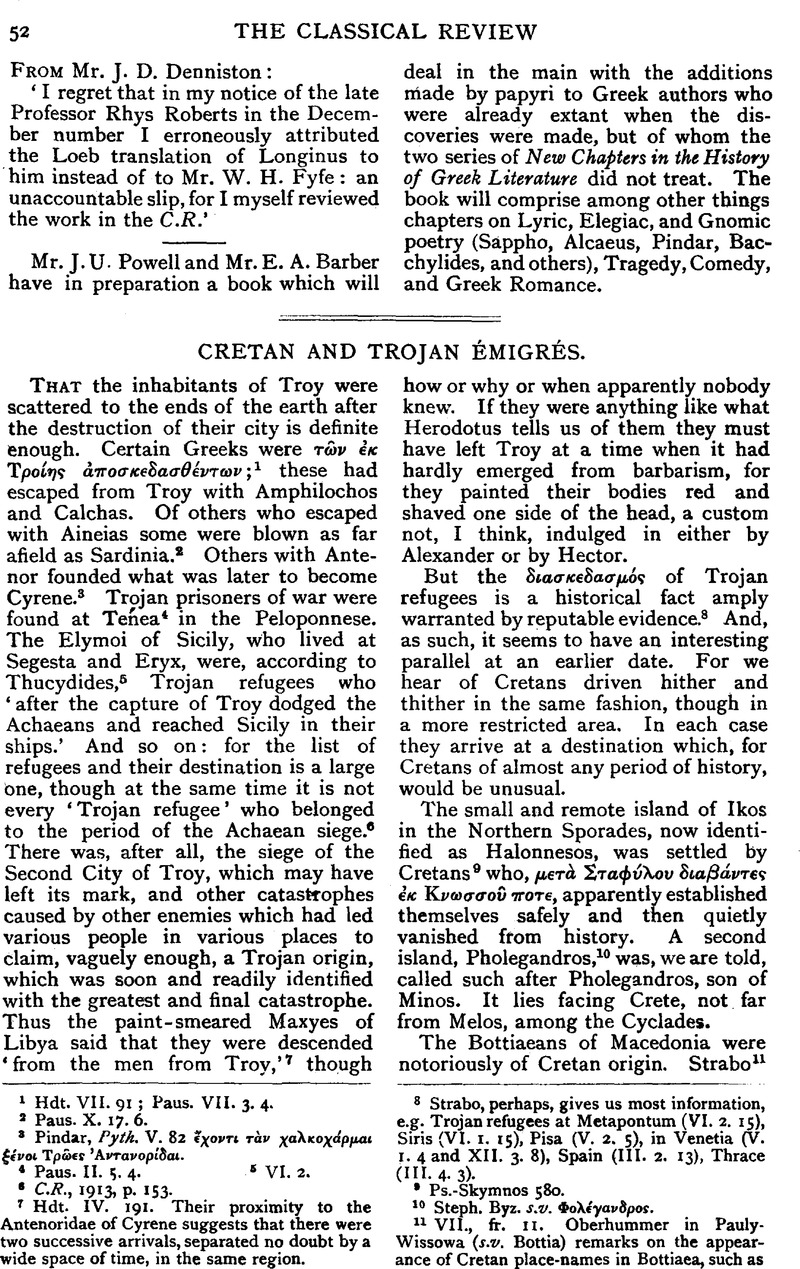No CrossRef data available.
Article contents
Cretan and Trojan Émigrés
Published online by Cambridge University Press: 27 October 2009
Abstract

- Type
- Review Article
- Information
- Copyright
- Copyright © The Classical Association 1930
References
page 52 note 1 Hdt. VII. 91 ; Paus. VII. 3. 4.
page 52 note 2 Paus. X. 17. 6.
page 52 note 3 Pindar, Pyth. V. 82 ἒχοντι τ⋯ν χαλκοχρμαιξ⋯νοι Tρ⋯ες'Aντανορ⋯δαι.
page 52 note 4 Paus. II. 5.4.
page 52 note 5 VI. 2.
page 52 note 6 C.R., 1913, p. 153.
page 52 note 7 Hdt. IV. 191. Their proximity to the Antenoridae of Cyrene suggests that there were two successive arrivals, separated no doubt by a wide space of time, in the same region.
page 52 note 8 Strabo, perhaps, gives us most information, e.g. Trojan refugees at Metapontum (VI. 2. 15), Siris (VI. 1. 15), Pisa (V. 2. 5), in Venetia (V. 1. 4 and XII. 3. 8), Spain (III. 2. 13), Thrace (III. 4. 3).
page 52 note 9 Ps.-Skymnos 580.
page 52 note 10 Steph. Byz. s.vΦολ⋯γανδρος.
page 52 note 11 VII., fr. 11. Oberhummer in Pauly-Wissowa (s.v. Bottia) remarks on the appearance of Cretan place-names in Bottiaea, such as Axios-Axos, Gortynia, and Europos. But these are not highly convincing.
page 53 note 1 Od. VII. 320.
page 53 note 2 I. 173.
page 53 note 3 Steph. Byz. s.v.Μον⋯γτσσα.Paus. VII. 3. 4.
page 53 note 4 Steph. Byz. s.v Γάζα
page 53 note 5 The word κρσφ⋯γετον offers attractive ground for speculation in this context. But the temptation is better avoided, for neither the etymology nor the meaning of the word is known. Nor is it likely that, in the form in which it survives, it contains any reference to Crete.
page 53 note 6 Childe, , Dawn of European Civilisation, p. 50Google Scholar; Hall, , Aegean Civilisation in the Bronze Age (1929), p. 81.Google Scholar
page 53 note 7 Hall, , Klio, 1928, pp. 335 ff.Google Scholar
page 53 note 8 Hdt. VII. 170 and Strabo VI. 3. 2.
page 53 note 9 VII. 170.
page 54 note 1 Strabo VI. 3. 2.
page 54 note 2 How and Wells wrongly say across the Adriatic.
page 54 note 3 Hall, , Aegean Civilisation in the Bronze Age, pp. 49 and 213Google Scholar; Burrows, , Discoveries in Crete, pp. 12 ff.Google Scholar
page 54 note 4 Burrows, op. cit., p. 141.
page 54 note 5 Hall, , Klio, 1928, p. 343Google Scholar. Lycians and Philistines are associated and both given a Caucasian origin. Hall thinks that they may have settled in South-West Asia Minor in the third millennium B.C. The Shardana of the fifteenth century B.C. were of the same race, and more recent arrivals from the same regions, at a time when the bulk of the immigrants had reached Syria. Exiled princes not infrequently visit regions where mercenaries are to be found.
page 55 note 1 Classical Philology (Chicago), October, 1929, p. 335Google Scholar, ‘ Itbakan Origins.’
page 55 note 2 ξ522–3.
page 55 note 3 ν344.




